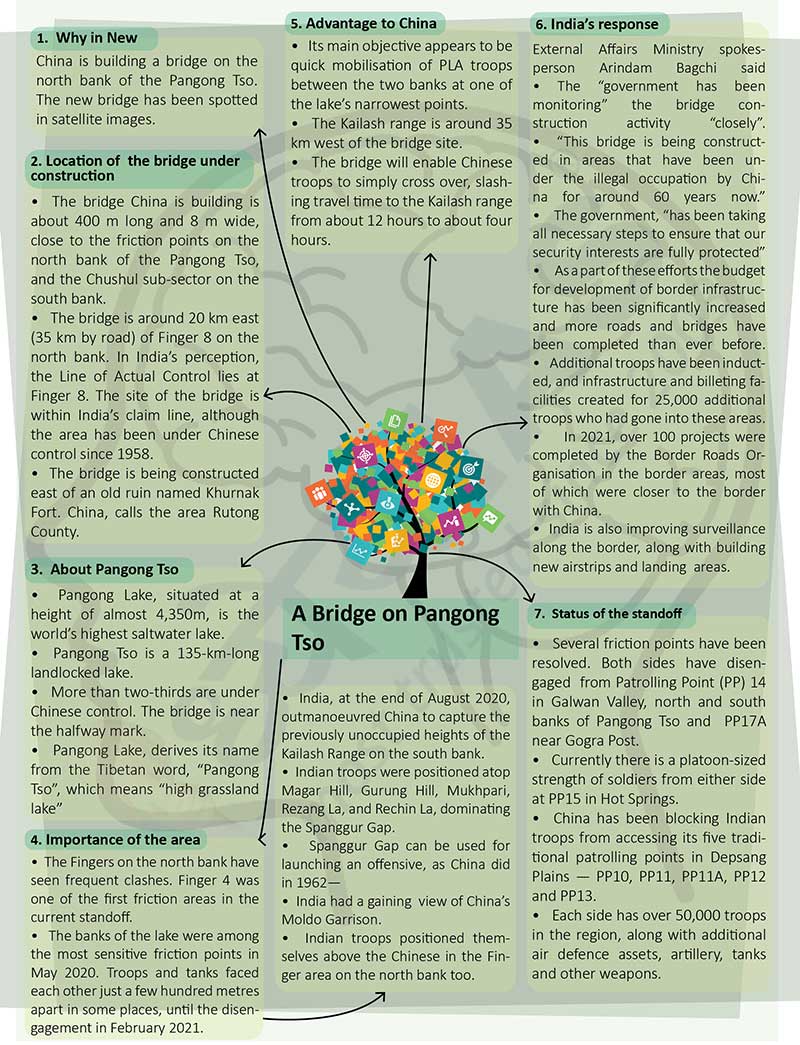Why in New?
- China is building a bridge on the north bank of the Pangong Tso. The new bridge has been spotted in satellite images.
Location of the bridge under construction
- The bridge China is building is about 400 m long and 8 m wide, close to the friction points on the north bank of the Pangong Tso, and the Chushul sub-sector on the south bank.
- The bridge is around 20 km east (35 km by road) of Finger 8 on the north bank. In India’s perception, the Line of Actual Control lies at Finger 8. The site of the bridge is within India’s claim line, although the area has been under Chinese control since 1958.
- The bridge is being constructed east of an old ruin named Khurnak Fort. China, calls the area Rutong County.
About Pangong Tso
- Pangong Lake, situated at a height of almost 4,350m, is the world’s highest saltwater lake.
- Pangong Tso is a 135-km-long landlocked lake.
- More than two-thirds are under Chinese control. The bridge is near the halfway mark.
- Pangong Lake, derives its name from the Tibetan word, “Pangong Tso”, which means “high grassland lake”
Importance of the area
- The Fingers on the north bank have seen frequent clashes. Finger 4 was one of the first friction areas in the current standoff.
- The banks of the lake were among the most sensitive friction points in May 2020. Troops and tanks faced each other just a few hundred metres apart in some places, until the disengagement in February 2021.
- India, at the end of August 2020, outmanoeuvred China to capture the previously unoccupied heights of the Kailash Range on the south bank.
- Indian troops were positioned atop Magar Hill, Gurung Hill, Mukhpari, Rezang La, and Rechin La, dominating the Spanggur Gap.
- Spanggur Gap can be used for launching an offensive, as China did in 1962
- India had a gaining view of China’s Moldo Garrison.
- Indian troops positioned themselves above the Chinese in the Finger area on the north bank too.
Advantage to China
- Its main objective appears to be quick mobilisation of PLA troops between the two banks at one of the lake’s narrowest points.
- The Kailash range is around 35 km west of the bridge site.
- The bridge will enable Chinese troops to simply cross over, slashing travel time to the Kailash range from about 12 hours to about four hours.
India’s response
External Affairs Ministry spokesperson Arindam Bagchi said
- The “government has been monitoring” the bridge construction activity “closely”.
- “This bridge is being constructed in areas that have been under the illegal occupation by China for around 60 years now.”
- The government, “has been taking all necessary steps to ensure that our security interests are fully protected”
- As a part of these efforts the budget for development of border infrastructure has been significantly increased and more roads and bridges have been completed than ever before.
- Additional troops have been inducted, and infrastructure and billeting facilities created for 25,000 additional troops who had gone into these areas.
- In 2021, over 100 projects were completed by the Border Roads Organisation in the border areas, most of which were closer to the border with China.
- India is also improving surveillance along the border, along with building new airstrips and landing areas.
Status of the standoff
- Several friction points have been resolved. Both sides have disengaged from Patrolling Point (PP) 14 in Galwan Valley, north and south banks of Pangong Tso and PP17A near Gogra Post.
- Currently there is a platoon-sized strength of soldiers from either side at PP15 in Hot Springs.
- China has been blocking Indian troops from accessing its five traditional patrolling points in Depsang Plains — PP10, PP11, PP11A, PP12 and PP13.
- Each side has over 50,000 troops in the region, along with additional air defence assets, artillery, tanks and other weapons.







